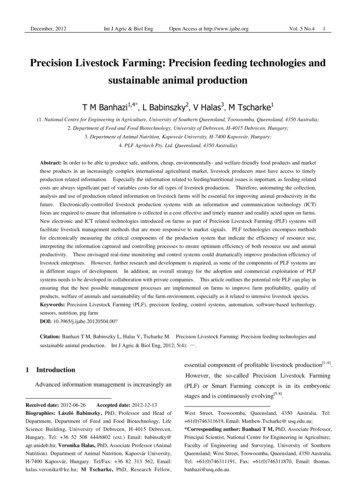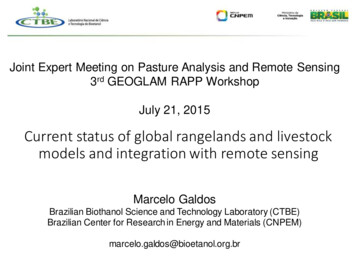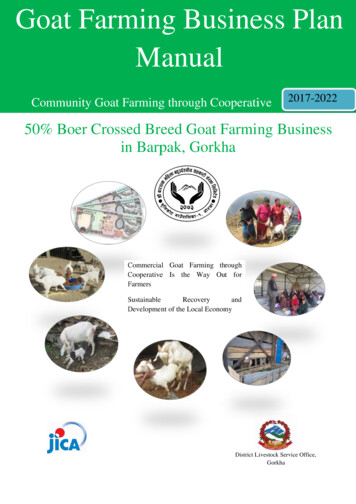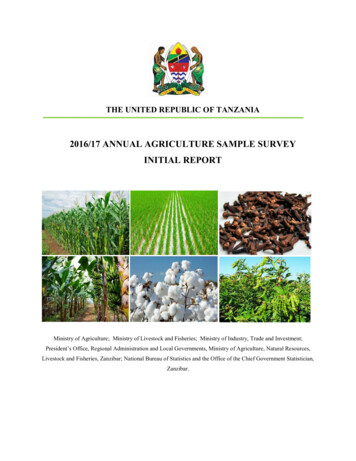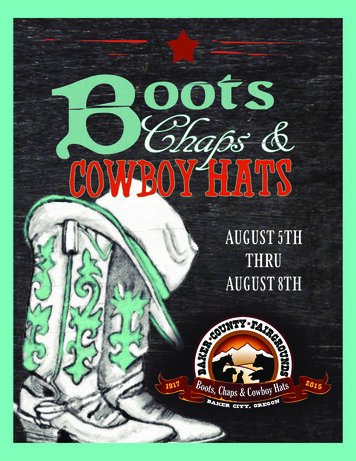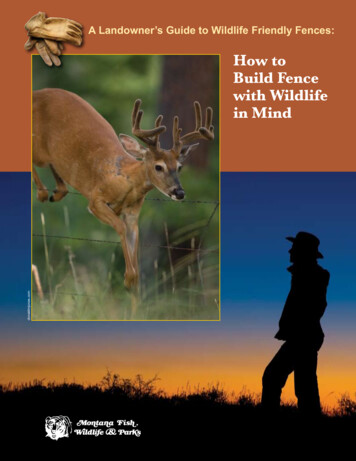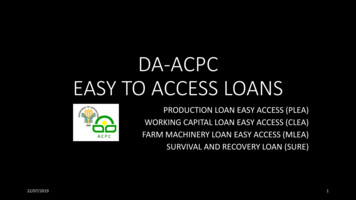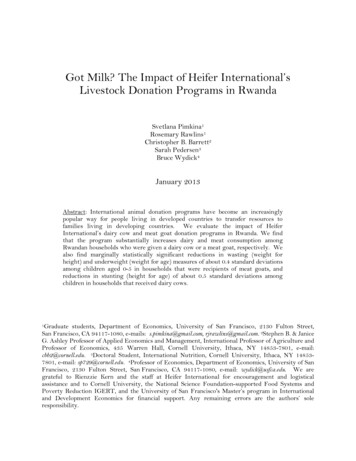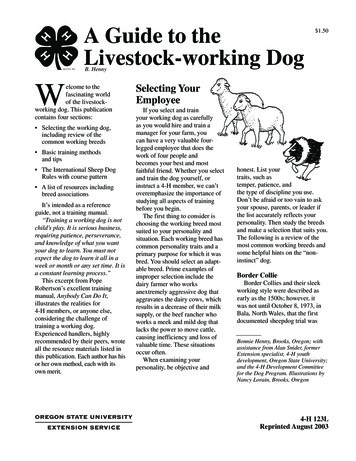
Transcription
A Guide to theLivestock-working Dog 1.50B. HennyWelcome to thefascinating worldof the livestockworking dog. This publicationcontains four sections: Selecting the working dog,including review of thecommon working breeds Basic training methodsand tips The International Sheep DogRules with course pattern A list of resources includingbreed associationsIt’s intended as a referenceguide, not a training manual.“Training a working dog is notchild’s play. It is serious business,requiring patience, perseverance,and knowledge of what you wantyour dog to learn. You must notexpect the dog to learn it all in aweek or month or any set time. It isa constant learning process.”This excerpt from PopeRobertson’s excellent trainingmanual, Anybody Can Do It,illustrates the realities for4-H members, or anyone else,considering the challenge oftraining a working dog.Experienced handlers, highlyrecommended by their peers, wroteall the resource materials listed inthis publication. Each author has hisor her own method, each with itsown merit.Selecting YourEmployeeIf you select and trainyour working dog as carefullyas you would hire and train amanager for your farm, youcan have a very valuable fourlegged employee that does thework of four people andbecomes your best and mostfaithful friend. Whether you selectand train the dog yourself, orinstruct a 4-H member, we can’toveremphasize the importance ofstudying all aspects of trainingbefore you begin.The first thing to consider ischoosing the working breed mostsuited to your personality andsituation. Each working breed hascommon personality traits and aprimary purpose for which it wasbred. You should select an adaptable breed. Prime examples ofimproper selection include thedairy farmer who worksanextremely aggressive dog thataggravates the dairy cows, whichresults in a decrease of their milksupply, or the beef rancher whoworks a meek and mild dog thatlacks the power to move cattle,causing inefficiency and loss ofvaluable time. These situationsoccur often.When examining yourpersonality, be objective andhonest. List yourtraits, such astemper, patience, andthe type of discipline you use.Don’t be afraid or too vain to askyour spouse, parents, or leader ifthe list accurately reflects yourpersonality. Then study the breedsand make a selection that suits you.The following is a review of themost common working breeds andsome helpful hints on the “noninstinct” dog.Border CollieBorder Collies and their sleekworking style were described asearly as the 1500s; however, itwas not until October 8, 1973, inBala, North Wales, that the firstdocumented sheepdog trial wasBonnie Henny, Brooks, Oregon; withassistance from Alan Snider, formerExtension specialist, 4-H youthdevelopment, Oregon State University;and the 4-H Development Committeefor the Dog Program. Illustrations byNancy Lorain, Brooks, Oregon4-H 123LReprinted August 20031
held. Ten dogs competed beforeseveral hundred spectators, and thewinner was a Scotch-bred dog.This dog originated near the borderof Scotland and England, and isnow known worldwide as theBorder Collie.Border Collies are primarilyblack and white with occasionaltinges of brown or red. They haveeither a long (rough) coat or a short(smooth) coat, stand approximately16 to 26 inches in height, andweigh approximately 40 pounds.The Border Collie is bred forintelligence, instinct, working style,and “eye”; not for color, coat, norsize.The most striking characteristicof the Border Collie is the “eye,”the dog’s power to control livestock with its eager watchful eyeswhile it crouches on the groundwith legs gathered under it forimmediate action. Border Colliesuse “eye” to establish authority andcontrol without overrunning thelivestock being worked. The “eye”is hereditary. Within the breed,dogs will show many levels of“eye” power, from very weak tovery strong. “Eye” power is uniqueto the Border Collie and does notcarry over well genetically when adog is crossbred.In top working dogs, “eye” and“power” are complementary traitsthat allow the dog to show no fear.Border Collies use their eyes as anenforcer and are able to communicate their courage to livestockwithout using roughness. Thisbreed is not inclined to jump in and2bite. It moves livestock with adirect, businesslike attitude.The variation in the power levelof the “eye” and the strength ofpersonality allow the breed to workany type of animal; however, itworks best with herding-instinctanimals (such as sheep). Thisability to work any animal is welldocumented by Arthur Allen in hisbook, A Lifetime with the WorkingCollie, Their Training and History,in which he describes two BorderCollies working a mountain lioninto a truck.The Border Collie is quick tolearn and easy to train. It canunderstand up to 60 commands ofboth whistle and voice, and isextremely affectionate to itshandler. It’s considered the mostintelligent of breeds. It’s the mostpopular breed of dog workingsheep and cattle at trials in theUnited States and Great Britain.The Border Collie is born with theinstinct to work. It’s very good inobedience trials, but can become ahandful if not given enough workto expend its energy. The breedgenerally thrives on large livestockfarms.In selecting a Border Collie, lookfor a dog that has good workingparents, medium-eye control, goodpower (neither flighty nor shy whenworking), and that is friendly to itshandler. It’s very helpful to know thebloodlines of the Border Collie, asstyle of work, level of “eye,” andinstinct are hereditary. Purchasing apuppy is the least expensive meansof acquiring the Border Collie. Youcan feel confident the pup will havethe instinct to work if you’re wellaware of the bloodlines.A reputable breeder is wellversed on the bloodlines and willguarantee the pup has the instinctto work. Many Border Colliesannually are purchased from GreatBritain, and many American-bornpuppies have imported parents.This does not imply that Americanbred dogs are inferior or thatimported dogs are better; however,bear in mind your needs and selectthe type of Border Collie bestsuited for your situation. This willallow you to obtain a good working dog more easily.Australian ShepherdThe Australian Shepherdoriginated in the Basque region onthe border between France andSpain. It worked for the Basqueshepherd for many generations,and may have immigrated to NorthAmerica with the Spanish settlersin the early 1800s.There is evidence the AustralianShepherd was imported to Australia from Spain with Merino sheep.In Australia, it was crossed withEnglish herding dogs to improveits herding ability, and then imported to North America, where ithad remained a purebred for manygenerations.
The Australian Shepherd canbe identified by its natural ordocked bobtail. Males stand 20 to23 inches tall; females 18 to21 inches. Average weight is40 pounds. The Aussie (commonnickname) may be blue Merle, redMerle, liver Merle, red, liver, orblack. Merle is described as anycoloration with flecks of anothercolor in it. Eyes are almond-shapedand may be any color. (Dogs withone blue and one brown eye arecommon.)The Aussie is a well-balanceddog of medium size and bone. It’sattentive and animated, and showsstrength and stamina combinedwith unusual agility. The dogshould be slightly longer than it istall. The coat should be of mediumtexture, straight to slightly wavy,weather-resistant, and of moderatelength with an undercoat. TheAustralian Shepherd is intelligent,primarily a working dog, anexceptional companion, versatile,and easily trained.The Australian Shepherd iscommonly known as a general-usefarm dog. It adapts well to smallfarms with limited work. Aswith all working breeds, selectionshould be based on bloodlines andworking style of the parents. TheAussie does not have the controlling “eye,” but does have strongworking instinct.Australian Cattle DogThe Australian Cattle Dog wasdeveloped in Australia exclusivelyfor working cattle in heavy brushor confinement. The breed is usedin America to work cattle, hogs,and horses. Its primary style is“heeling,” defined as driving theanimal by biting low on the heels.The Australian Cattle Dog (alsocalled the Blue Heeler) weighsapproximately 33 pounds; malesare 18 to 20 inches in height, whilefemales are 17 to 19 inches. It maybe blue-mottled, with or withoutblack, or red-speckled with darkerred markings on the head. A blueheaded dog may be marked withblack and tan, with tan legs.The Australian Cattle Dog has amoderately short coat, straight andmedium textured, with a short,dense under coat. It’s a bold,strong, well-muscled dog that canwithstand harsh conditions. Arecognized American Kennelbreed, it has specific standards forsize, color, coat, and marketing.The breed usually is very aggressive and strong-minded, and hasbeen bred to withstand a kick fromcattle without backing off. A welltrained Australian Cattle Dogworks effectively in stockyards andrough country. It can be difficult tohandle with sheep, dairy, orpoultry, and takes patience to train.The Australian Cattle Dog is wellknown for its loyalty and protective instinct. Australian CattleDogs often become self-appointedguardians of their owners’ herdsand property.Australian KelpieThe Australian Kelpie is a lithe,extremely active, and intelligentdog with tireless gait and a stronginstinct to work. It’s sometimesreferred to as a “desert BorderCollie.” It’s a short-coated, prickeared dog that revels in difficultterrain. The Australian Kelpie wasestablished specifically for desertor tough terrain where it could“muster huge areas under extremeconditions, often having to dowithout water for hours on end.”It can be black, black and tan, red,red and tan, fawn-chocolate, orsmoke-blue. Males are 18 to20 inches in height; females 17 to19 inches. The Kelpie weighs about25 to 30 pounds. This breed is verysturdy and strong, but light boned.The Kelpie usually is found to havegreat endurance and energy andexcellent working instincts. It worksin an upright (standing) position, notflattened to the ground, and has amild amount of controlling “eye.”In the United States, welltrained Kelpies adapt to large herdsof any type of livestock. Handlersmust be aware of the Kelpies’speed and endurance when selecting the breed. Sometimes withsmall flocks, the dog tends to runcircles around the flock, primarilybecause it was developed to workvery large herds of sheep.The Kelpie originated in Australia in the mid-1880s, when threepairs of black and tan “working3
collies” were imported from GreatBritain. The intermixing of thestrain helped stabilize the breed.At the time the black and tan“working collies” were imported toAustralia, the Border Collie wasknown as “the black-and-white,rough-coated “working Collie.”Please note: The AustralianKelpie, Australian Cattle Dog, andthe Australian Shepherd are threedistinct breeds, each developed fora specific and different purpose.Also, the Border Collie and theAustralian Kelpie are included inthe Miscellaneous Class of theAmerican Kennel Club.Bearded CollieThe Bearded Collie is amedium-sized, long-coated dogthat originated in the highlands ofScotland where it was used forherding sheep. These dogs weresent up into the hills where theyworked independently as“huntaways” searching for lost orhiding sheep, running and jumpingover hilly terrain while barkingto move the sheep from undercover. They would then gather theflock together and bring it in tothe shepherd. There used to beinterbreeding between Beardies(common nickname) and BorderCollies in Scotland, resulting in astrain more closely resembling theBorder Collie. The two strains ofBeardies, Border strain (grey andwhite) and the Highland strain(brown and white), are indistinguishable today due to inter-breeding.4It’s thought that some of the firstancestors of the breed werebrought from Poland in 1514 bytraders coming to Scotland to tradegrain for Scottish sheep. Therecords state that one of theScottish shepherds traded a ramand ewe for a dog and two bitches.Beardies range in size from 20to 23 inches (at the shoulder) formales and 19 to 22 inches forfemales. Their color can vary fromblack to silver and chocolate tosandy, with or without whitemarkings. The topcoat is long,harsh, and flat, while the undercoatis soft, furry, and dense. BeardedCollies are intelligent, affectionate,stable, untiring, and good withchildren.As with all other workingbreeds, selection of a pup shouldbe made by looking for workingparents. The Beardies are popularin dog shows and as house companions. The well-trained workingBeardie is not as easy to find asthe working breeds previouslymentioned. The Bearded Collie isregistered through the AmericanKennel Club and has a specific setof standards.Other BreedsIf you select your working dogfrom another working breed, suchas the Corgi, McNab, EnglishShepherd, Sheltie, or Collie, studyeach breed thoroughly for style ofwork, availability of provenworking bloodlines, and the currentprimary purpose forwhich the breed isbeing used. Beaware that manybreeds, includingthose we’ve discussed, are beingbred for conformation shows and notexclusively for working ability. Thiswill affect the natural workinginstinct of the dog.Take time in selecting your dog!Breeders will be patient if you aresincere and determined in yourselection process. Nothing can bemore frustrating to a new owner orthe breeder than when a puppy isreturned due to lack of understanding about the breed purchased.Within reason, any breed can beused to do minimum work aroundthe farm with careful, strict training. Many breeds, such as theGerman Shepherd, originally werebred to herd livestock but may nowhave a very different purpose inlife and no working instinct left.When you train a dog with noinstinct (remember, chasing is notinstinct), it must be completelytrained to all obedience anddirectional commands prior tointroducing it to livestock.Two excellent training manuals,The Farmer’s Dog by John Holmesand A Lifetime with the WorkingCollie, Their Training and Historyby Arthur N. Allen, demonstratetraining methods helpful withinstinct and “non-instinct” dogs.
Once non-instinct training hasbegun, the handler must confinethe dog whenever it’s not beingsupervised. Never allow the dog towork on its own. The dog will notunderstand its purpose and cancause a great deal of damage to thelivestock. A well-trained, noninstinct dog will work quiteeffectively in simple herding tasks,but will never develop the fieldmaneuverability of a workingbreed.Studying the breeds of workingdogs and their bloodlines as well asyour personality and needs is thefirst step toward selection.Next is an extremely importantfactor, the environment of the dogbefore and after purchase. A wellsocialized puppy with constanthuman companionship will show thepurchaser an honest picture of thetype of personality it may have atmaturity. The pup or young dogdeprived of human companionshipmay be shy and uninterested orbehave over-aggressively as aresult of its environment, nevergiving a clue to its true personality.The purchaser must be aware ofboth the environment the dog camefrom and the environment in which itwill be placed. If you purchase a shyor uninterested dog that has workingbloodlines and place it in an environment of constant socialization and nocompetition with other dogs, it’slikely to develop into an eager andfaithful working companion.Purchase a well-adjusted pup,give it constant affection, andcontinually bolster its confidence.When a dog has confidence initself, it will have the power tomove the animal wherever itshandler requests, and will knowthat its master will assist in a calmmanner when difficulties arise.Power is two-staged; power tomove the animals is hereditary, butthat power will not develop to itspotential unless the dog hasconfidence.Basic TrainingMethods and TipsA highlight in family life isbringing home the new puppy.Contrary to popular belief, familysocialization is a very good starttoward training a working dog.Socialization bolsters confidence.Many professional handlers withgrown families farm out a youngpup (similar to the guide dogprogram) to a child to raise until it’sapproximately 11 2 years old. Duringthat time, the young dog willdiscover itself, learn basic obedience(“come,” “sit,” and how to behave),and mature. This early trainingmakes it easier for the young dog toaccept the strenuous training required to become a working dog.If a handler starts with a puppy,socializes it, and completely trains itto a mature working dog, the handlerwill find the dog much more dedicated and willing to work than thehandler who purchases a started dogor hires the training done. A dogwith more than one owner during itsearly years requires more time todevelop allegiance to its handler, andit will continue to worry aboutchanging handlers again. Thesedogs, especially the Border Collie,are highly intelligent animals withvery long memories.Throughout the life of yourworking dog, you must maintainfirm control. Because of theirintelligence, working dogs willtake matters into their own handsand ignore the handler if given thechance. This becomes especiallytrue during the teenage months,usually from 6 months to 11 2 years.The younger dogs often are calleddelinquents! The handler will startwith an eager pup, which willaccept and understand commandsin a very short training time. All ofa sudden, the young dog willignore the commands, especially“come” and “sit,” and the handlerswill wonder if someone switcheddogs overnight.Don’t be alarmed; this is usuallythe time when the working instinctstarts developing and the dog’slegs begin to realize their fullmobility. It’s a very trying time forthe handler, and requires patiencewith firm training. Many experienced handlers who maintain slow,firm training eliminate or reducethe teenage stage. It’s importantthat dogs respond to the commands“come,” “sit,” and “that will do”(see “Common Commands,”page 10) when you give them.Reinforce or retrain the commandsany time the dog does not respond.The most common error in thefield, or at trials, is that the dogdoes not respond to the first stopcommand. This can cause havocwhen working livestock.5
Do not discipline your dogunless it completely understandsthe command and still does notrespond. Firm control does notmean physical discipline. Control isgiving a command and workingwith the dog until it executes thecommand immediately no matterwhere the command is given—inthe house or in a mud puddle. Eachdog must be disciplined accordingto its personality. A soft, easytempered dog will respond to aslight tug on the choke chain or afirmly raised voice (not yelling)when discipline is needed.Use physical discipline only on abold and aggressive, “hardheaded”dog that understands the command,but after being reprimanded onceby normal discipline, returns tomake the same severe mistake.Physical force should be applied bythe human hand, never with amaterial object. Physical disciplinerarely is used, but often misused. Ifthe dog is consistently making thesame mistake, return the dog to theleash and retrain the command.Many times, this reinforcement canbe invaluable training. Sometimes,it’s an indication the dog did notoriginally understand the command. The hardheaded dog is themost difficult to train.However, oncewell-trained,6a hardheaded dog will be able towithstand very difficult situationswithout being intimidated.The 4-H sub-novice and noviceobedience can be very helpful andwill not harm a working dog. It’simportant to keep all training short(10–15 minutes per day) and fun.Add tricks and lots of praise, notfood. Be patient. Train one command at a time and do not allow thedog to be bored. If you find the dogacting lazy or uninterested, stoptraining it for a week or two. It canbe helpful during a serious period oftraining to keep the dog tied andallow it off the lead only for training,followed by play time. This caninstill a “let’s get to work” attitude ina dog not showing a strong dedication or willingness to work.Try to have the dog be a constant companion, but when you’regone, confine the dog to prevent itfrom working on its own. If thedog is a family pet, designate oneperson to train, feed, and care forit, especially during the initialtraining period. Once the familydog is working, it normally willobey anyone in the family, butwill perform best for the originalhandler.Likewise, unless ahandler with two dogs canwork them independentlyfrom each other as abrace, each dog he or sheowns should work alone.The handler must separatelytrain each dog, never allowing the old dog to teach the youngone. A dog must take orders fromthe handler, not another dog.Jealousy is common in the two-doghousehold. Because of the henpecking order found in dogs, ayounger dog entering the territory ofan older one can cause a great dealof strain between handler and dogs.Extra companionship, individuallygiven, and patience usually willallow the dogs to live and work inrelative peace.Remember, you are training thedog to be your employee andfriend. As an employer, the betteryou train your employee, the betterit will work. Thus, do not expectimmediate results. Take time andpatience and your “friendship” willlast longer with less frustration!A puppy should be allowed tobecome a mature dog before goingto work. Puppies with stronginstinct can try to work as early as8 weeks, and should be givenducks to move. Don’t allow thepuppy to work large livestock, as itdoes not have the leg power,confidence, instinct, or maturity tohandle the charging animals. You’llfind it much more difficult to trainthe pup to forget a bad experiencethan to prevent the experience inthe first place. Even when a dog is2 years old, allow it to test anysituation and be prepared to assistso the dog won’t lose confidence.The handler’s knowledge of thelivestock being worked is often aforgotten necessity. You mustknow how the livestock will reactin any given situation, and when togive assistance or correct your dog.Successful handlers strive tounderstand at least half of what theirdogs know.
Starting the dog on livestockyou intend to work requires carefulplanning. Begin with easy andfree-moving stock in a confinedbut spacious pen, where you canhave control of the situation at alltimes and the dog can gain confidence in its ability to work thestock as you command. Never usepet stock such as bummer lambs,because they tend to ignore anydog and do not react as a normalherd of stock would.We urge you to read the threetop training manuals: Anybody CanDo It; A Lifetime With The WorkingCollie, Their Training and History;and A Farmer’s Dog.Anybody Can Do It describeseach step of training and assumesthe dog to have a good workinginstinct. It is by far the bestpictorial of each training step, butthe reader must read every word tocompletely understand what theauthor intends to say. It does notwaste words, and is considered tobe top of the line for training aBorder Collie.A Lifetime with the WorkingCollie, Their Training and Historyis written by one of the grandfathers of the American BorderCollie Breeders. It has excellenttraining methods, different fromAnybody Can Do It, and very goodhistory of some famous BorderCollies along with some interestingtales of the author’s dogs.A Farmer’s Dog is a much olderpublication than the others and canbe used in training all workingbreeds. It offers slightly differenttraining methods.These three books offer excellent advice and each should bereviewed on its own merit.Starting with a well-bred,working breed pup and training thedog yourself is the best investmenttoward a good working dog. Somehandlers prefer to purchase astarted or fully-trained workingdog. If you purchase a started ortrained dog, selection is morecritical, but often less research isrequired than when buying apuppy.Not only should you view thedog’s ability in a given situation,but if at all possible, visit a fewtimes with the breeder and dogprior to purchase. It’s common fora professional handler purchasing atrained dog in Great Britain totravel overseas and spend up to amonth with the original owner andthe dog. This helps the trainer learnabout the dog’s environment, itstemperament, the original handlers,stage of training, and hereditaryfactors. An imported dog comeswith a tape of commands, bothwhistle and voice, because the dogunderstands the command with theaccent used. If you purchase a dogfrom a different part of the country,be aware of the original handler’saccent, since you must imitate anyaccent in the commands to obtainthe correct response.If the dog is well bred and welltrained, you’ll be investing a lot ofmoney in its purchase. You shouldbe prepared to invest a lot of timeand patience after the dog arrivesat its new home, too. Remember,your dog is your employee, andyou do not expect a new employeeof the farm to work perfectly aftera week on the job. Why should youexpect that of a new dog? The dogmust accept the new environmentand attach confidence and companionship to the new handler. Besides, the dog did not ask for thejob; you took the dog away fromits master.Making a difficult decision issomething handlers often face.Sometimes, because of handlererror, improper breed selection,incompatibility between dog andhandler, or between the dog’sworking ability and the job, ahandler must decide how toeliminate a family member (thedog) and start over. This isextremely difficult if the dog is achild’s pet, and it may be impossible. Only the owner can knowhow to proceed.If there is room to house morethan one dog, it may be practicalto purchase another. However, ifthe dog has killed or maliciouslyattacked livestock, it must bedestroyed, because there is no cureand the behavior will happenagain. If you’re a 4-H leader, andyou and the parents agree the dogwill go no further, decide on aunited strategy to inform the4-H’er, who often will alreadyhave realized the problem.7
All three parties can then decidehow to proceed. If, as a leader, youare not sure how to proceed in thetraining of a certain team of 4-H’erand dog, contact a professionalhandler. The “Resources” section(page 12) lists national and localclubs. Contact the club secretary,who will refer you to a localhandler.This information is not intendedto discourage you from teaching ortraining a working dog. However,even in the best circumstances,failure is possible. Unlike dogobedience, where patience andtime will allow any dog to learnbasic obedience, not every dog canbe a working dog. Professionalhandlers know that many dogs canbe useful workers on the farm, butthe excellent dog may come onlyonce in a lifetime, if at all.The basic commands on pages10–11 will work a handler throughan average working day, providingthe handler is using a stronginstinct dog that wants to work andplease its handler. Always havestrong enforcement on the “stop”and “that will do” commands. Thiswill allow you to correct anysituation before it can get too farout of control.8Sheep Dog TrialsThe OutrunIn starting each run, the contestants and their dogs shall takeposition at a designated point nearthe pen—this position to be “fixed”position for all work until thecompletion of the second gate andpreparation for the pen. With thesheep in place, and upon a signalfrom the Course Director, the runfor each dog begins. On the outrun,the dog may be directed to goeither “right” or “left,” and eachdog shall run a pear-shaped outrununtil beyond the sheep (approximately 10 to 11 o’clock position).Crossover, or disposition tocrossover, shall cause deduction ofpoints at the judge’s discretion.The LiftThe introduction of dog to sheepshould be cautious and donecalmly, without frightening thesheep. Properly done, the liftrequires the dog to control thesheep quietly and firmly, withoutunduly startling them, and moveoff in a straight line with completecontrol.The FetchThe fetch should be on a straightor near-straight line through thefetch panels from the point ofcontact and lift to the handler.Swerving, zigzagging, wide andhard flanking, or other deviationsfrom the near-straight line willcause loss of points. The nature ofthe work, conditions, and handlingof the sheep are all considered. Thefetch ends when the sheep arearound the handler and in control.The DriveThe drive begins with drivingthe sheep behind the handler and,normally, behind the pen in astraight or near straight line toGate 1, left gate; driving the sheepthrough Gate 1 (away from handler), then horizontally across thefield to and through Gate 2, rightgate, in a straight or near straightline. Points can be deducted forfailure to completely send all sheepthrough the gates (usually 1 pointdeducted for each sheep), for anysheep coming back through thegate after it has been attempted, orfor deviation from a straight ornear-straight line during any part ofthe drive. Scoring will stop at fetchif drive is not attempted.The drive ends when the sheepare through Gate 2. Once the sheephave passed either gate, no reentryis allowed. The contestant shallproceed to the pen. The dog isrequired to bring the sheep up forpenning.The PenThe pen is set not less than 10yards outside the driving field. Thepen shall be anchored securely atthree points, but in such a way thatthe gate may open to the right orleft, at the discretion of the handler.The opening corner of the pen shall
be the one nearest to Gate 2 on thedriving field. A 6-foot cord shall beattached to the end of the openinggate. The handler is allowed tohold the cord to the end but notfarther. The handler shall direct thedog to pen the sheep unassisted,and shall close the gate only whenthe sheep are completely inside thepen. Points may be deducted forexcess movement during the penattempt. No points are given for anunsuccessful attempt.The ShedThe shed shall be attemptedonly after a pen is completed. Thehandler opens the pen and movesthe sheep out in the open field. Thehandler directs the dog to controlthe sheep in a designated area, andcommands the dog to split andhold a determined nu
your dog to learn. You must not expect the dog to learn it all in a week or month or any set time. It is a constant learning process.” This excerpt from Pope Robertson’s excellent training manual, Anybody Can Do It, illustrates the realities for 4-H members, or anyone else, considering the challenge of training
